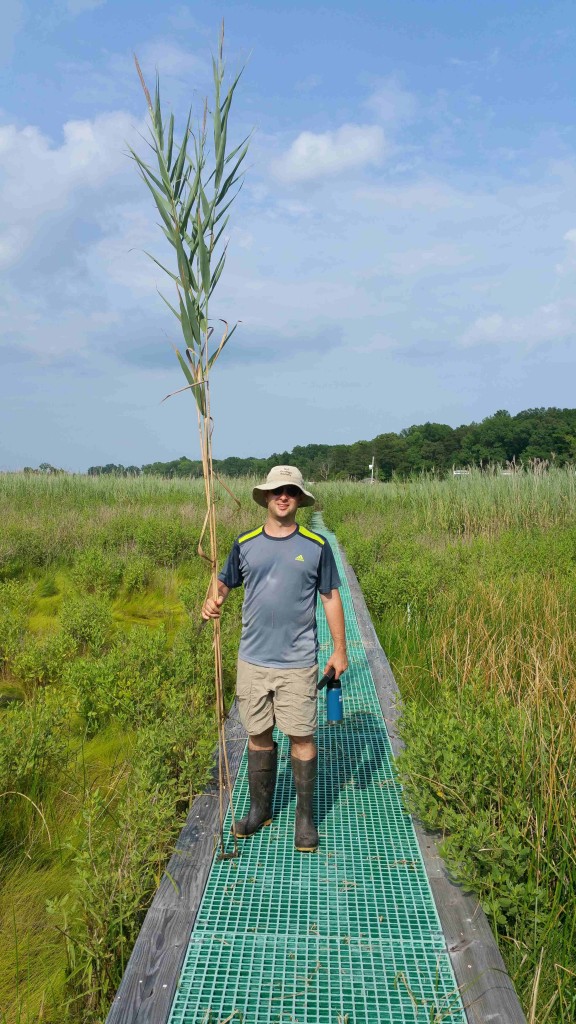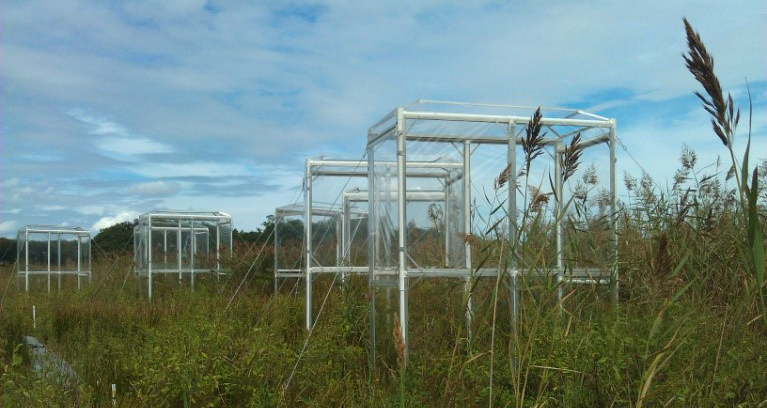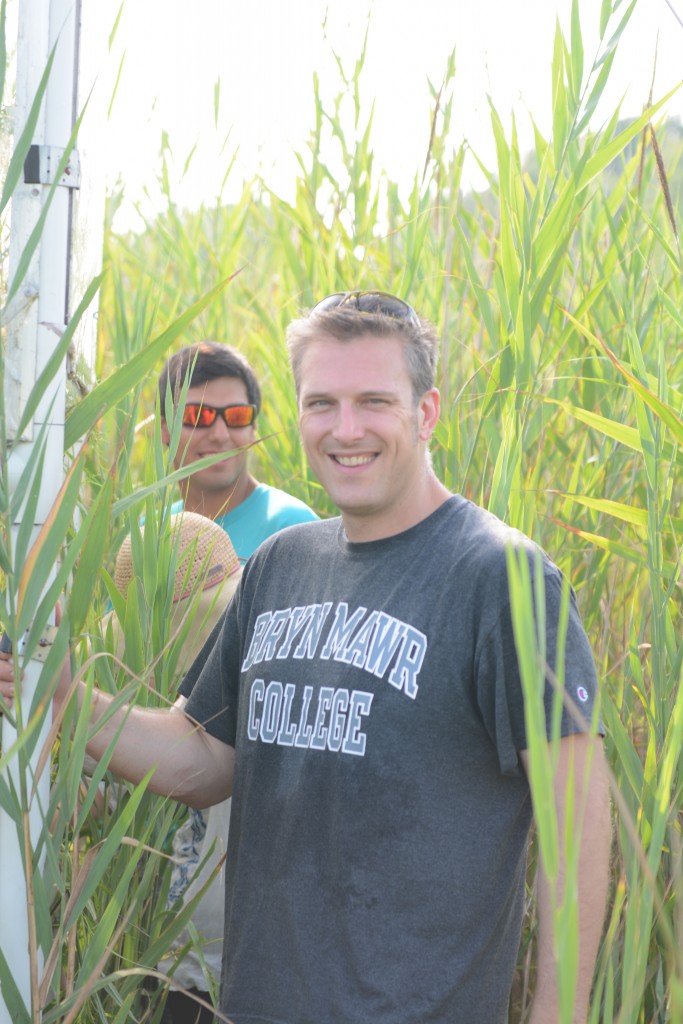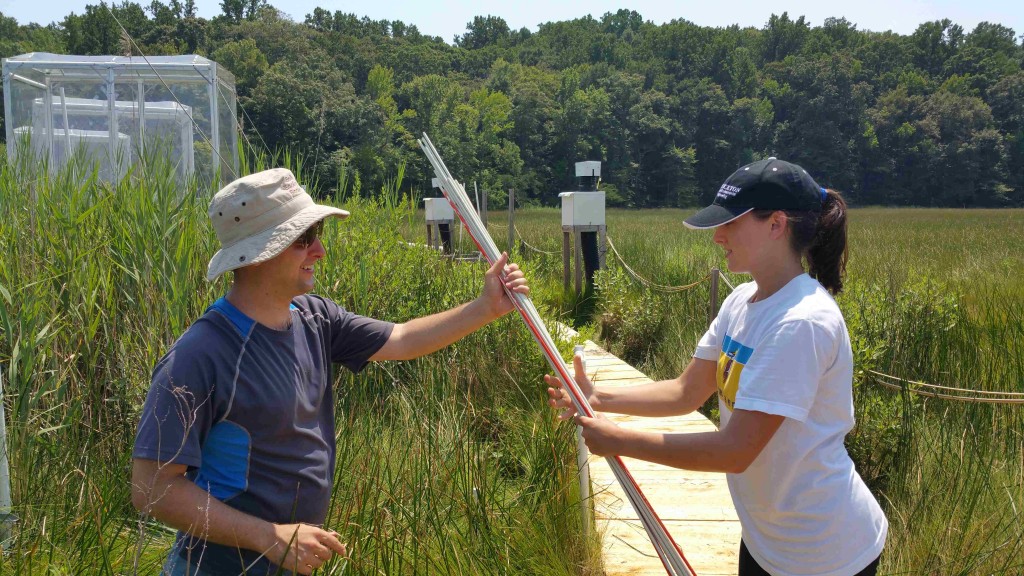by Kristen Minogue

Ecologist and lead author Josh Caplan holds a Phragmites plant at the Global Change Research Marsh. Invasive Phragmites can grow up to 15 feet tall. (Thomas Mozdzer)
One of the Chesapeake’s least favorite invaders could end up being an unlikely savior. The invasive reed Phragmites australis, a plant that has exploded across Chesapeake wetlands in the last few decades, is also making those wetlands better at soaking up carbon, ecologists from the Smithsonian Environmental Research Center (SERC) and Bryn Mawr College discovered in a new study.
The common reed, better known as Phragmites australis, grows in dense clusters up to 15 feet tall. North America has several native strains that have co-existed peacefully with many other native plants for at least 30,000 years. It is the invasive strain that arrived from Eurasia in the 1800s that has scientists and environmental managers worried. Eurasian Phragmites grows taller and denser than North American Phragmites, crowding out many smaller plants, and blocking access to light and nutrients. These changes in plant community have a ripple effect on animals that rely on wetlands for habitat.
“The fish communities, the insect communities, the soil and invertebrate communities, all these things change when Phragmites comes in,” says lead author Josh Caplan, a Bryn Mawr postdoc and visiting scientist at SERC. Often, those changes aren’t for the better. “Phragmites is doing a number to these ecosystems.”
Jekyll and Hyde
On the surface Phragmites has all the makings of a classic ecological horror story: A non-native species arrives in a new land, unwittingly brought over in foreign ships. It lies low for a century or so to build a critical mass, and then launches a silent invasion. But there’s a reason ecologists call it the “Jekyll-and-Hyde plant.” What Phragmites does belowground–particularly regarding its ability to store carbon—tells a very different story.
To get the full picture, Caplan and a team of researchers ventured to the Smithsonian’s Global Change Research Wetland in Maryland, a.k.a. the “wetland of the future.” In 1972, scientists found a single stand of Phragmites on the wetland. Today the plant has taken over 25 percent of it.

Wetland of the future. In these experimental Phragmites chambers, ecologists pump extra CO2, nitrogen or both to simulate the possible world of 2100. (Thomas Mozdzer)
At the global change wetland, ecologists run experiments to uncover how plants will cope in the projected world of 2100. On the boundary of the Phragmites line, they built 12 clear, open-top chambers, with approximately one-third of each chamber enclosing the encroaching Phragmites reeds. Three of the chambers they left alone as controls mimicking current conditions. In the other nine, they created one of three possible futures: a world with higher nitrogen pollution, a world with higher CO2, and a world with both.
Phragmites flourished in all of them. “It’s one of these super plants,” says co-author Thomas Mozdzer, a Bryn Mawr assistant professor. Mozdzer began the Phragmites experiment on the wetland in 2011 while working at SERC as a Secretary’s Distinguished Research Fellow. “It’s one of these plant that does really well under any condition.”
But more astounding to Caplan and Mozdzer was the plant’s aptitude for soaking up carbon. Compared to the other species on the marsh, Caplan says, “it pretty much blows everyone out of the water.”

Ecologist Thomas Mozdzer stands in a patch of Phragmites in the Global Change Research Wetland. (Kim Holzer)
Under normal conditions (no change), and when they raised just CO2, Phragmites took up twice as much carbon as native plants. But in the chambers with extra nitrogen, Phragmites took up three times as much carbon.
What gave nitrogen this power? Plants use nutrients like nitrogen to make chlorophyll, the green pigment they need to photosynthesize. Phragmites plants with higher nitrogen were also able to grow larger canopies, making them able to photosynthesize more and store more carbon.
The extra doses of nitrogen had another benefit: They also allowed Phragmites to stay green longer. Normally, plants turn brown in the fall because they stop making green chlorophyll and move their nutrients belowground. The added nitrogen in storage allows Phragmites to start growing and photosynthesizing right away the next year. In the chambers with extra nitrogen, Phragmites could begin growing earlier. Additionally, nitrogen pollution allowed Phragmites to stay green longer in the fall, enhancing growth.
“If we want to limit Phragmites invasions, we need to reduce nitrogen,” says Mozdzer. Nitrogen holds the key to keeping the invader in check. But both researchers agree that may no longer be the wisest course of action.

Josh Caplan (left) and volunteer Katelyn Williams do Phragmites field work during “Marsh Madness,” the two-week data collection blitz on the Global Change Research Wetland every summer. (Thomas Mozdzer)
A Question of Survival
Phragmites does more than pull carbon dioxide from the atmosphere. It also builds up more soil belowground—which could save wetlands from succumbing to sea level rise.
“Sea level rise is endangering these coastal marshes to the point where they may not even exist,” Caplan says “Sea level rise may wash them away.”
In the Chesapeake, that process has already begun. The Bay has lost more than 500 islands since the 1600s, and another, Tangier Island, is poised to become uninhabitable in the next 50 years. If the Chesapeake loses its wetlands, it would lose the protection they offer from storm surges. Homes and business would be more vulnerable to floods. The Bay would also be more vulnerable to pollution, without wetlands to filter it out.
Instead of trying to eradicate Phragmites en masse, the authors suggest, a better course may be to prioritize—and possibly allow it to remain in spots especially vulnerable to sea-level rise. Otherwise, says Mozdzer, we run the risk of not having many coastal wetlands at all.
“At the end of the day, we may have to decide, do we want marshes that support biodiversity, or do we want marshes that can keep pace with sea level rise?”
This study was published in the November issue of the journal Environmental Research Letters. Patrick Megonigal and Rachel Hager also contributed to the research. A full copy of the paper is available here.

